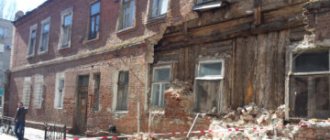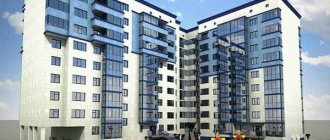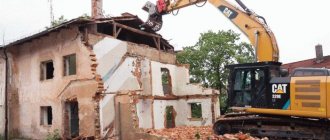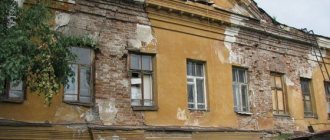What is “dilapidated housing”? Our house is dilapidated, as they explained to me, due to the fact that the wear of its structures is more than 70%, but there are no plans to demolish it yet. What is the difference between dilapidated housing and emergency housing? Can dilapidated housing be habitable?
Answer:
The concept of “dilapidated housing” is not defined in the legislation of the Russian Federation. Neither the Housing Code of the Russian Federation, nor the provision “On recognizing premises as residential premises, residential premises unsuitable for habitation and an apartment building as unsafe and subject to demolition or reconstruction”, approved by the Decree of the Government of the Russian Federation of January 28, 2006. No. 47 does not contain any mention of dilapidated housing. At the same time, this concept is widely used both in the names of various federal and local programs “for the regeneration of areas of dilapidated and dilapidated housing”, the resettlement of citizens from dilapidated and dilapidated housing, and is mentioned in judicial acts.
Dilapidated housing. Dilapidated condition of the building. Definition of the concept
The dilapidated condition of a building is a condition in which the structures, foundation (building as a whole), as a result of high physical wear and tear, no longer meet the specified operational requirements (“Methodological recommendations for protecting the rights of participants in the reconstruction of residential buildings of various forms of ownership” (approved by Order of the State Construction Committee of the Russian Federation dated November 10. 1998 N
The definition of the concept of “dilapidated condition of a building” is also contained in the Methodological manual for the maintenance and repair of housing stock MKD 2-04.2004 (approved by the State Construction Committee of Russia; not officially published).
In this manual, disrepair is defined as follows:
Dilapidated condition of a building is a condition in which the structure of the building and the building as a whole has wear and tear: for stone houses - over 70%, wooden houses with walls made of local materials, as well as attics - over 65%, the main load-bearing structures retain strength sufficient to ensure stability of the building, but the building no longer meets the specified operational requirements.
At the same time, the load-bearing structures of the building are building structures that form the building layout specified by the project, ensuring its spatial stability under calculated external influences.
Percentage of depreciation of a house to recognize it as unsafe
Many criteria and internal regulations do not give a clear idea of which houses are unsafe and which are not? The percentage of wear must be at least 70% . The figure is calculated using construction formulas and a calculator. However, in practice, this scheme does not always work.
Expert opinion
Dmitry Nosikov
Lawyer. Specialization: family and housing law.
There are cases when the unsuitability rate was at the level of 75%, but the house remained stable. In fact, it can be considered dilapidated and not in disrepair. Even despite the high percentage of wear and tear, which seems to correspond to emergency status.
There are also counter examples. Houses with up to 60% deterioration are ready to collapse. Residents complain about problems with ventilation, airflow, destruction of walls and dampness in the basement. Changes in the design strength make it possible to recognize such a house as unsafe.
What may cause the unsuitable condition of the house:
- natural influences – natural factors in the form of rain, snow, wind, ultraviolet effects (gamma rays), as well as geological shifts of the earth. Additionally, wear is affected by cataclysms: floods, avalanches, hurricanes, earthquakes, tornadoes;
- human impact - errors in architectural calculations, poor quality of raw materials, poor soil and foundation strengthening, lack of repair and restoration of the building, negligence of engineers and housing inspection employees.
The determination of the wear percentage is calculated on the basis of VSN 53-86 (Gosstroy order No. 446). The work is carried out by specialists from the commission for technical assessment of buildings. Executing companies must be members of a non-profit SRO partnership.
Ordinary residents do not participate in the assessment. However, they have the right to join the interdepartmental commission. Such a commission receives a report from experts and, based on it, makes a conclusion whether to recognize the MKD as an emergency or not. The procedure takes place in the form of voting by all members of the commission, including representatives from the multi-apartment building.
Emergency housing
Emergency condition of a building , according to the above-mentioned Methodological Manual MKD 2-04.2004, is a condition of a building in which more than half of the residential premises and the main load-bearing structures of the building (walls, foundations) are classified as emergency and pose a danger to the lives of residents.
At the same time, the emergency condition of the load-bearing structures of the building is the state of the load-bearing structures of the building, in which the structures or part of them, due to natural wear and tear and external influences, have excessive deformations and damage, have lost their design strength and, without strengthening measures taken, can cause an emergency condition of the residential premises or the entire residential premises buildings and pose a danger to residents.
A separate load-bearing structure of a building in the condition described above, if its collapse does not affect other structures or does not entail a change in living conditions or operation of the residential building as a whole, is considered pre-emergency.
It is not difficult to notice that if dilapidated housing (the dilapidated condition of a building) is characterized by a high degree of wear and tear of its structures without the danger of their collapse and, accordingly, does not pose a danger to life, then emergency housing has deformations and damage to load-bearing structures and living in this residential premises is life-threatening due to the real possibility of collapse.
Thus, the mere fact of deterioration of a building (above 70%) is not a sufficient basis for the conclusion that the building is in disrepair or unsuitable for habitation for other reasons. In addition, the legislation provides for the procedure for declaring residential premises unfit for habitation. According to paragraph 7 of the Regulations “On recognizing premises as residential premises, residential premises unsuitable for habitation and an apartment building as unsafe and subject to demolition or reconstruction”, approved by the Decree of the Government of the Russian Federation of January 28, 2006. No. 47, “Recognition of a premises as a residential premises suitable (unsuitable) for citizens to live in, as well as an apartment building as unsafe and subject to demolition or reconstruction, is carried out by an interdepartmental commission created for these purposes (hereinafter referred to as the commission), based on an assessment of the compliance of the specified premises and house with the established requirements in these Regulations. According to clause 42 of this provision, the Commission, on the basis of an application from the owner of the premises or an application from a citizen (tenant) or on the basis of the conclusion of bodies authorized to conduct state control and supervision on issues within their competence, assesses the compliance of the premises with those established in this Regulation requirements and recognizes the residential premises as suitable (unsuitable) for living, and also recognizes the apartment building as unsafe and subject to demolition or reconstruction.
How is dilapidated housing different from emergency housing?
Thus, the mere fact of deterioration of a building is not a sufficient basis for the building to be recognized as unsafe or unfit for habitation. The wear of the structure can be from 70-80% and even reach 90%. Housing is considered unsafe if there is a risk of the house collapsing and it is dangerous to stay in it. Such a house may have complete or partial destruction of the foundation, load-bearing walls, roof and other elements of the building. And housing will be considered dilapidated if the structure only shows wear and tear, but at the same time its load-bearing elements retain strength.
Question answer
Will Khrushchev buildings be demolished throughout the country?
Dilapidated housing is housing that is unfit for habitation. Arbitrage practice
In judicial practice, there is a position according to which dilapidated housing is, by definition, housing unsuitable for habitation. For example:
“..The legal concept of dilapidated housing is housing that is precisely unfit for habitation, which is confirmed by a number of legal documents” (Appeal ruling of the Supreme Court of the Republic of Bashkortostan dated May 27, 2014 in case No. 33-7217/14)
In another case, the court stated:
The argument of the appeal that, in accordance with the established procedure, according to the conclusion of 2011, the specified house was not recognized as unsafe, the judicial panel cannot recognize as justified, since the disputed house is included in the Program for the resettlement of citizens from dilapidated housing stock. In the Program, the concept of “dilapidated residential buildings” should include residential buildings classified as unsuitable for permanent residence on the basis of significant physical deterioration.
The procedure for recognizing residential premises as unfit for habitation is established by Decree of the Government of the Russian Federation of January 28, 2006 No. 47 “On approval of the Regulations on recognizing premises as residential premises, residential premises unsuitable for habitation and an apartment building as unsafe and subject to demolition or reconstruction” (Appeal ruling of the Supreme Court Republic of Bashkortostan dated November 29, 2012 in case No. 33-12732/2012).
Rights of residents of a dilapidated building
Those who live in the house subject to relocation retain the rights to similar housing in terms of footage and number of rooms. Providing objects without surface finishing is prohibited. Communications must not only be connected, but also work without long interruptions. If the house is not ready to move in, you will have to wait until all systems are fully commissioned and launched.
The resident should contact the responsible person in the administration, where relocation options are offered. You can refuse one of the options in favor of a more acceptable one. But the best options are offered the first time. Residents of dilapidated houses have the right to prompt relocation if the house is in a life-threatening condition.
What can the owner expect?
Measures are being taken against the owners:
- written notification is sent by mail;
- the condition of the housing is assessed;
- a relocation agreement is signed.
The owner has the opportunity to both receive a similar apartment and count on compensation. The state has an obligation to pay the funds at the request of the owner. A redemption price is offered, which you can either agree to or set a higher price. If there is no agreement, the dispute is resolved in court. It is possible to issue an apartment with a larger area, but with an additional payment.
What can an employer expect?
Housing is also provided to those who live in municipal apartments on a social rent basis. Accommodation is offered, which should be viewed in advance. No compensation is provided, because the basis for its payment is ownership of the property. The tenant uses the apartment for an indefinite period; he can live in it, but not manage it.
According to Art. 85, 86 and 89 of the Housing Code of the Russian Federation, when moving from a municipal apartment, local authorities are obliged to provide similar housing. In this case, a new social tenancy agreement is concluded on the same terms. The apartment must be well-equipped, no less than the previous one in terms of area.
Requirements for new housing
The apartment provided to replace the emergency one is equipped with bathrooms and communications. A final finishing is required and the slabs are installed. The area in front of the house is properly landscaped. Parking spaces within walking distance, recreation areas and playgrounds are being installed. Areas for collecting household waste are being established. The new living space must be no smaller in area.
As a result, there is a possibility of recognizing the building as unsafe. The procedure includes providing a standard list of documents and following a strict sequence of actions. A decision is made to provide residents with apartments in the new building.
Dilapidated housing under previous legislation
In the current housing legislation, as indicated above, there is no concept of dilapidated residential buildings, which is replaced by unfit for habitation.
Earlier, before the adoption of the Regulations “On recognizing premises as residential premises, residential premises unsuitable for habitation and an apartment building as unsafe and subject to demolition or reconstruction”, approved by the Decree of the Government of the Russian Federation of January 28, 2006. No. 47, the Regulation “On the procedure for recognizing residential buildings (residential premises) as unfit for habitation” was in force, approved by the Decree of the Government of the Russian Federation of September 4, 2003. No. 552. This Regulation contained the concept of “dilapidated condition of housing”.
Thus, according to clause 2 of the Regulations (approved by Resolution No. 552), residential buildings (residential premises) are considered unsuitable for living:
a) in dilapidated condition;
b) in disrepair;
c) in which the harmful effects of environmental factors have been identified.
According to clause 3 of the Regulations, the criteria and technical conditions for classifying residential buildings (residential premises) as dilapidated or in disrepair are approved by the State Committee of the Russian Federation for Construction and Housing and Communal Services.
Major repairs or reconstruction
If a house is considered dilapidated but can be repaired, the municipality is obliged to provide residents with temporary housing. Such residential premises usually contain a flexible fund, the apartments of which are initially intended for vulnerable categories of citizens.
All residents are guaranteed to return to their place of residence after repairs. The exception is situations when, after a large-scale reconstruction of the premises, they have seriously changed their area. And the tenant can no longer claim such an apartment. If this happens, the municipality buys the living space from the owners. In this case, the timing does not matter.
[smartcontrol_youtube_shortcode key=”what is recognized as dilapidated housing” cnt=”1" col=”1" shls=”true”]
Compensation or relocation, which is better?
When you are offered relocation from emergency housing, there are two options:
- Adopt and move
- Get compensation
If you decide to get an apartment, you need to register it as your property and obtain documents from Rosreestr. To do this you must provide:
- Passport of a citizen of the Russian Federation
- Document giving ownership
In case of refusal to provide housing, citizens may demand payment of monetary compensation. To do this, an application is submitted to the body responsible for the implementation of resettlement, which justifies the reason for abandoning the apartment, and also attaches a document certifying ownership. Compensation is calculated from the market value of the residential premises that the authorities planned to provide instead of the damaged one.
What kind of housing is not considered emergency?
The home inspection is carried out in accordance with regulatory requirements. The experts’ task is to identify signs of housing disrepair. If there are no signs, the building is not subject to demolition.
What indicates the dilapidation, and not the disrepair of housing:
- Availability of communications (light, water, heating), while 1-story and 2-story houses may not have part of the communications.
- There is protection from dampness, moisture and fungus - elevator shafts, entrances, basements, technical rooms meet SanPiN standards.
- The supporting and load-bearing structures of the MKD remain stable - even if they are damaged, the integrity of the building and the health of people are not threatened.
- Permissible percentage of temperature in the house: from 18 degrees and less than 60% humidity.
- Minor deviations from the norm of the building foundation.
As we found out, dilapidated houses cannot be demolished. But if residents have doubts about the examination data, they can appeal it. For example, by conducting a second independent examination , albeit at your own expense. If she confirms that the house can be considered unsafe, you need to go to court and challenge the administration’s conclusion.
Is the house subject to demolition as emergency housing?
The conclusion is made by an interdepartmental commission, and then by the city executive committee. However, their decision may include errors, distortion of facts and violation of the MKD inspection procedure. The residents, of course, don’t know about this. Therefore, even if the house is in disrepair, it is only recognized as dilapidated. Achieving justice alone is difficult. But there is an opportunity to seek help from a lawyer. On our website you will receive advice on your issue. A lawyer will help with recognition of the status of a dilapidated house. If necessary, he will also tell you the procedure for appealing the commission’s conclusion in your city or district. Attention!
- Due to frequent changes in legislation, information sometimes becomes outdated faster than we can update it on the website.
- All cases are very individual and depend on many factors. Basic information does not guarantee a solution to your specific problems.
That's why FREE expert consultants work for you around the clock!
- via the form (below), or via online chat
- Call the hotline:
- Moscow and the Region
- St. Petersburg and region
- FREE for a lawyer!
By submitting data you agree to the Consent to PD Processing, PD Processing Policy and User Agreement.
Anonymously
Information about you will not be disclosed
Fast
Fill out the form and a lawyer will contact you within 5 minutes
Tell your friends
Rate ( 2 ratings, average: 5.00 out of 5)
Author of the article
Maxim Privalov
Lawyer. 2 years of experience. I specialize in civil disputes in the field of housing and family law.
Author's rating
Articles written
610









